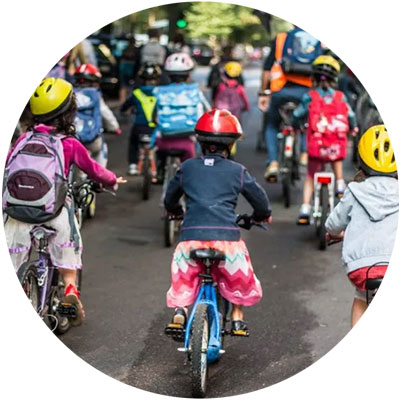Vision
Changing the way people move daily in the territory of the Metropolitan City of Milan by increasing the bicycle mobility can positively affect not only the transport sector but the entire society and economy of the city.

Objectives
Quantitative objectives
Achieve by 2035 the 20% of total journeys and 10% for inter-municipal journeys by bicycle as modal split.
Qualitative objectives
Make cycling the fastest, safest, most fun and most attractive mobility choice. The most obvious choice for each person and for all daily travel, even inter-municipal.
How we are changing
 + ENVIRONMENTAL PROTECTION
+ ENVIRONMENTAL PROTECTION
Reducing pollutant and climate-changing emissions from the transport sector, which contributes more than 50% of PM10 and NOx emissions and therefore to the worsening of local air quality in the territory and 29% of CO2 emissions (INEMAR, 2017).
 + SAFETY
+ SAFETY
Reducing the number of road accidents and their severity, in particular by reducing the involvement of vulnerable road users (cyclists and pedestrians in particular).
 + ECONOMIC DEVELOPMENT
+ ECONOMIC DEVELOPMENT
Stimulating job creation in the sustainability sector, promoting the local production and favouring the short supply chain, the circular economy and the territory and Italy’s labour. Investments in cycling and walking, in fact, have a multiplier effect on the economy that is double compared to investments in car production (IEA (2020), Sustainable Recovery, IEA, Paris).
Decreasing road congestion, especially in metropolitan areas during peak time, contributing to the increase in economic productivity of the territory as a consequence.
 + WELL-BEING FOR ALL
+ WELL-BEING FOR ALL
Significantly decreasing the levels of physical inactivity and sedentary lifestyle, which are responsible for 15% of all deaths in Italy and whose associated social costs are estimated at over 12 billion euros per year (CEBR, 2015). The WHO recommends the use of the bicycle as a mean of daily transport to achieve the "minimum levels" of daily physical activity for adults but also for children and the elderly (WHO, 2020).
Guaranteeing a mobility option, and thus increase accessibility to services and goods, to all residents and in particular to those in economically and socially disadvantaged conditions. Cycling can help in reducing "poverty of access" and multiplying social and economic opportunities for low-income populations.





